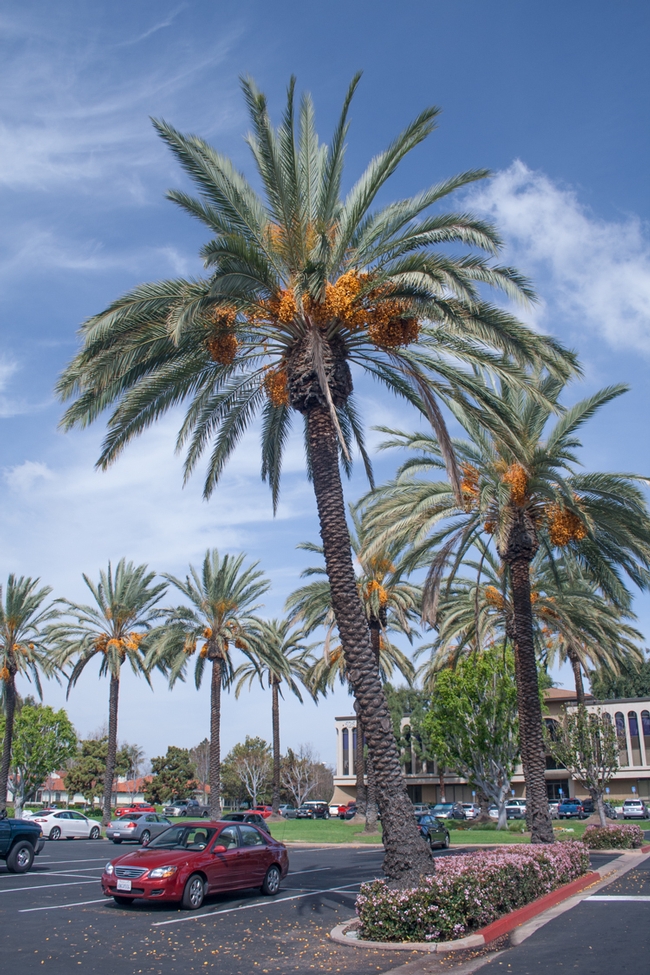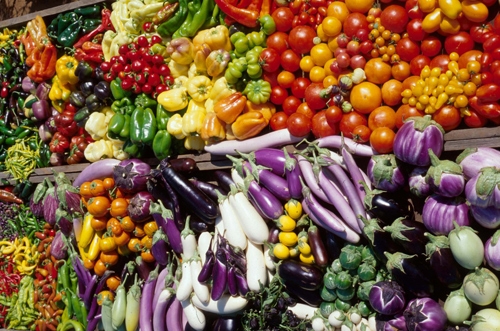UC Food and Agriculture Blogs
Ornamental landscape date palm: An overlooked urban fruit tree
One fruit, though, is not on the radar of foodies and foragers. Yet it's crunchy, sweet, flavorful, often seedless, and very common in Southern California landscapes. It's the fruit of the date palm, rarely thought of as a food source in our urban environment, more frequently viewed as a nuisance because dates fall off trees, where they create litter that must be cleaned up.
Unfortunately, coastal Southern California lacks the high sustained heat and aridity for proper fruit maturation and curing to produce traditional soft-ripe dates of good eating quality. The dates that fall from the trees have been unattractive to gather for sale and consumption, processes that could help to resolve the fruit litter problem in the landscape.
However, some varieties of dates can be eaten at a less than a mature state, traditionally called “khalal.” Fruit in the khalal stage have attained their maximum size, are typically yellow or red, have a sweet flavor, and are crunchy, somewhat like an apple. Several date varieties, like ‘Barhee,' are sometimes sold and eaten in the khalal stage. Fortunately, from a food standpoint (or unfortunately if you are a landscape manager), date fruits do mature to the khalal stage in coastal Southern California because high sustained heat and aridity are not required to attain this stage of development.
While ‘Barhee' is not too common as a landscape subject, another variety, ‘Zahidi,' is common and typically produces abundant fruits in coastal Southern California. These golden yellow fruits are conspicuous and showy in the khalal stage, are typically on the palm for several months from late fall to spring, and are really good to eat. Also, in many cases, these fruits are seedless! (Note to horticulture geeks: date palms are dioecious - separate male and female trees - and because nearly all edible date palms in the landscape are female, their flowers were pollinated by other species of landscape Phoenix. The resulting hybrid fruits are seedless, or pollination is not required for fruit to set and develop - parthenocarpy.)
Urban foragers looking for their next food adventure, or even a potential enterprise, might want to consider taking advantage of this otherwise nuisance and unwanted fruit. Khalal fruit can be gathered from the ground and cleaned. But it is best to collect them off the palm. Cutting an inflorescence (entire fruit stalk) and lowering it carefully to the ground would be ideal.

Khalal-stage fruits of the date variety ‘Zahidi’ are really good to eat: crunchy, sweet, and flavorful. Also, they are seedless (D. R. Hodel).
IPM for Lace Bugs
Lace bugs are small, sculptured insects with lacey wings. They suck sap from plants causing leaf stippling and bleaching, and they often foul leaves with specks of dark excrement. Several dozen species may occur in the western U.S. Landscape plants...
New Lady Beetle Quick Tip
Lady beetles, commonly called “ladybugs” are easily recognized by their round or half-dome shape and short, clubbed antennae. Almost all species are predators of insects or mites in both adult and larval stages. Some species specialize on...
Choosing healthy foods might be easier than you think
Doctors say we'll live longer if we exercise and eat right. Okay, but what does that mean, exactly? You hear so much about super foods and super diets that knowing how to “eat right” can be super confusing.
It doesn't have to be. Liz Applegate, a nutrition and fitness expert from UC Davis, has teamed up with Nugget Markets (a chain of nine markets which serve the greater Sacramento Valley) to present a “21-day Healthy Eating and Exercise Challenge,” an easy plan for making health a permanent part of our lives.
“This isn't about starving yourself or biting off more than you can chew at the gym,” Applegate says. “It's about making good-for-your-body decisions, rather than punishing you with cutting calories and tough-to-do workouts.”
Applegate teaches nutrition at UC Davis, including a wildly popular online and in-person nutrition course that attracts several thousand students each year. She's a triathlete, a sports nutrition columnist for Runner's World, an author of several sports nutrition books, director of sports nutrition for Intercollegiate Athletics at UC Davis, and a consultant for Olympic athletes.
In short, she knows her stuff. And when it comes to healthy eating, she says, don't over-think it.
“Eating well isn't about being perfect, but about finding out what food has to offer, and striking a balance between your needs, personal preferences, culture and family experience,” she says.
That philosophy is central to her healthy eating and exercise challenge, which you can pick up at any Nugget Market or download from its website here. Applegate's shopping list includes a wide variety of tasty foods — a bounty of fresh vegetables, various meats and poultry, fish, eggs, grains, dairy, chocolate and much more. What's not to like?
- Eat breakfast. A solid morning meal sets the stage for a good day of healthy eating.
- Eat some protein at every meal to manage weight and support your exercise.
- Whole grains like brown rice, quinoa and whole wheat are your friends (unless you cannot tolerate gluten. If so, stick with brown rice and other non-wheat products).
- Aim for at least 2½ cups of veggies and 2 to 3 pieces of fruit each day.
- Include healthy fats from fish, nuts and seeds. Use olive, canola or avocado oils.
- Aim for 2 to 3 servings of calcium-rich foods like dairy or soymilk. Each day, eat a probiotic such as yogurt or kefir for digestive and immune support.
As for fitness, the plan provides a do-at-home circuit of strength training exercises, such as planks, push-ups, squats and leg lifts. Her general rules are:
- Switch things up. You'll build stronger muscles when you try different types of exercises.
- Aim for 30 to 60 minutes of moderate to vigorous activity five to seven days a week. Anything that boosts your heart rate counts — fast walking, jogging, bike riding, swimming, dancing, basketball, you name it. If you can't find time for 30 minutes straight, 10 minutes here and there will do the trick.
- Include three to five do-at-home strength-building sessions that help shape and tone major muscle groups while building core strength.
Adjusting to healthy eating and routine exercise takes time, Applegate says, so don't be too hard on yourself.
The joy is in the journey.
Spring Treatments for Backyard Fruit Tree Insects: Codling Moth
[From March 2013 issue of the Retail Nursery and Garden Center IPM News.] March is the time to start preparing to manage codling moth on apples and pears in backyard trees. Left unmanaged, the insect can be devastating to the crop. Life Cycle. The...






